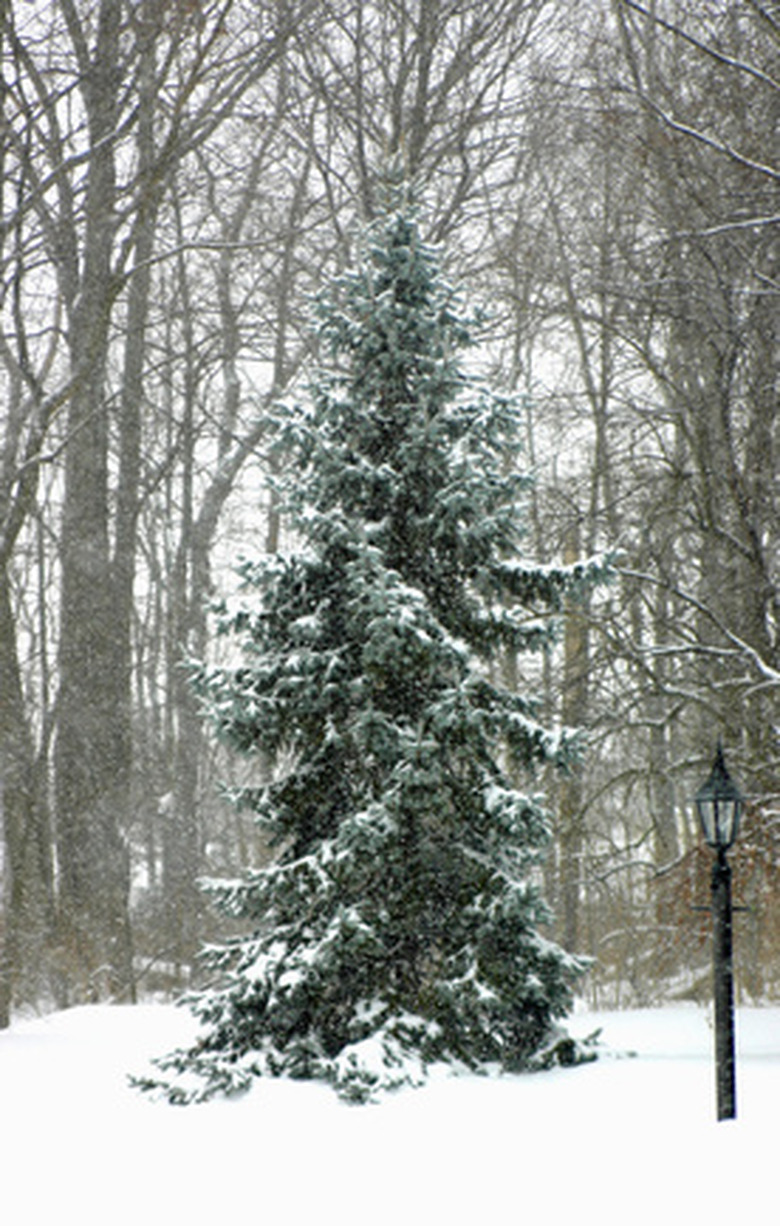How To Prune A Norway Spruce
Things Needed
- Hand pruners (secateurs)
- Loppers
- Pruning saw
The tall shape and graceful, drooping branches of Norway spruce (Picea abies) may make pruning more challenging since you don't want to destroy the natural form and beauty of the tree. While dead branches warrant removal at any time, trimming back growing branches in increments allows you to create the desired tree shape without accidentally removing too much. Removing branch tips promotes more side branching and removing or trimming lowest branches allows for better pedestrian or vehicle access. Norway spruce trees grow in U.S. Department of Agriculture Plant Hardiness Zones 3 through 7.
Step 1
Look over the entire tree, focusing on any dead or damaged branches that need full removal.
Step 2
Cut off dead or yellowing, diseased branches with a hand pruners, making a crisp one-motion cut 1/4-inch above a lower branch junction or in the middle of the stem among live needles. If the branch is larger than 1/2-inch in diameter, consider using a loppers to make the cut. Even larger branches or those needing removal flush with the tree trunk are best removed with a hand-held pruning saw.
- The tall shape and graceful, drooping branches of Norway spruce (Picea abies) may make pruning more challenging since you don't want to destroy the natural form and beauty of the tree.
Step 3
Look at the very top of the spruce tree. Only one growing tip or vertical twig, called the leader, should exist. Remove any competing leaders from the tree tip, making the pruning cut 1/4-inch above their attachment to the main leader/trunk. Do not accidentally prune off or damage the leader while you thin out the unwanted, competing leader twigs.
Step 4
Scout the overall shape of the Norway spruce after all dead and diseased branches are gone. Look for balance among the size, length and distribution of the remaining branches. Also not if any particularly long or errant branches or twigs pose a nuisance over a sidewalk or driveway. Earmark these branches for trimming.
- Look at the very top of the spruce tree.
- Remove any competing leaders from the tree tip, making the pruning cut 1/4-inch above their attachment to the main leader/trunk.
Step 5
Trim back branches noted in Step 3, using the appropriately size pruning tool. Make pruning cuts 1/4-inch above lower branch junctions if you are trimming back branch tips. If a branch must be more severely cut back, make the anywhere along the branch that currently possesses needles–barren branches will not sprout back. Consider cutting back barren branches to a lower branch junction or the tree trunk rather than leaving an awkward leggy branch.
Step 6
Reduce the length of dangling branches by snipping them at varying lengths to preserve their graceful habit. Avoid shearing the branches all at the same height; retain the natural, jagged, pendent look of the Norway spruce's branch structure.
Step 7
Hold back pruning if you are uncertain about desired length. You can always trim later again in late winter. It's better to err on the side of under-pruning a Norway spruce than over-pruning and creating unnatural looking pruning wounds.
- Trim back branches noted in Step 3, using the appropriately size pruning tool.
- Make pruning cuts 1/4-inch above lower branch junctions if you are trimming back branch tips.
Tip
Consider pruning back branches in midsummer once all the current growing season's growth has flushed out. You can then see the new length of branches and trim or prune back accordingly to get the right length and look on the tree. To maintain a branch length, trim off emerging new growth buds in mid-spring before it elongates and expands. Tall Norway spruce trees warrant the use of ladders, extension poles, or an arborist. Use an arborist with safety equipment to tackle pruning projects and concerns high in the tree.
Warning
New prune spruce branches back into nude areas where no needles grow. New tip buds will only rejuvenate from pruning cuts made on areas of branches that are cloaked in needles. Never "top" a Norway spruce. "Topping" is the harsh, blunt removal of the upper leader or general upper tip of the tree. Once removed, the tree with form a structurally weak, multi-branched replacement top that will not look good.
